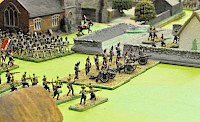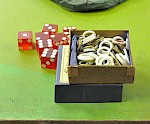Going "old skool" (part 1)
 In our quest for the ultimate rules set for Ligny (see WSS 70), we had agreed as a group to try several rule sets with the aim of finding one that would best reflect Napoleonic battles in our group’s opinion. Last Wednesday, we decided to give In the Grand Manner a go. The rules were brought in by Malcom, who used to play them at the Grimbsy club two or three decades ago. The rules themselves were written by Peter Guilder in 1972: some players weren’t even born when these were written (I was then four years old).
In our quest for the ultimate rules set for Ligny (see WSS 70), we had agreed as a group to try several rule sets with the aim of finding one that would best reflect Napoleonic battles in our group’s opinion. Last Wednesday, we decided to give In the Grand Manner a go. The rules were brought in by Malcom, who used to play them at the Grimbsy club two or three decades ago. The rules themselves were written by Peter Guilder in 1972: some players weren’t even born when these were written (I was then four years old).
Now, of course, just because a rule set is old doesn’t mean it’s not good. I think an open mind is essential when trying out games and also being wary that one freak result does not alter your judgement.
Mal provided us with a hand-written play-sheet for the game, measuring in at four leafs (eight pages). I guess the original didn’t come with one. Some players did pale at the sight of that, but it was largely self-explanatory and saved a lot of thumbing through the rules. So we ploughed bravely into the game despite the fact Mal had not played it for a while.
The game has a twelve step “period sequence” each turn. We decided to forgo the need for writing written orders (which is required for charges and firing canister), trusting each other to be “good gentlemen” about it.
 Movement is simultaneous, from right to left alternately. Charges are declared and moved before normal movement. As both sides were moving at the same time but from opposite ends of the board, it was pretty quick and gave some surprising results when you caught up to see what your opponent had moved. The speed of a unit is dependent on if its in line or column, with better trained troops moving slightly faster. Movement was pretty standard (4” for infantry in line; 8” if they charge). Cavalry move significantly faster than infantry (typically 10” in line) and can cover huge distances when they charge (typically 21”).
Movement is simultaneous, from right to left alternately. Charges are declared and moved before normal movement. As both sides were moving at the same time but from opposite ends of the board, it was pretty quick and gave some surprising results when you caught up to see what your opponent had moved. The speed of a unit is dependent on if its in line or column, with better trained troops moving slightly faster. Movement was pretty standard (4” for infantry in line; 8” if they charge). Cavalry move significantly faster than infantry (typically 10” in line) and can cover huge distances when they charge (typically 21”).
There is no command and control per se; units can move freely. Instead, the game’s focus is on morale. Tests are required to charge (or being charged), when receiving casualties from shooting, if friendly units are routing within 12”, and to see if a unit stays in melee.
 Artillery and musket fire uses different mechanisms. For artillery, roll a D10 to see if you hit your target. Then you total up the number of hits from a battery and cross-reference it with a table. E.g. I have two hits from 8lbrs firing canister, worth 12 points in total, so I look up 12 points and cross reference it with a roll of 2D6 plus any modifiers. I roll a 9 and cause two casualties. Casualties are counted in individual figures, so we used plastic rings to mark our bases. Musketry is done differently, by adding up the number of figures that can fire and rolling 2D6 on the table for casualties. Skirmishers are lethal: you roll a D6 per model to cause casualties (typically on a 5–6)!
Artillery and musket fire uses different mechanisms. For artillery, roll a D10 to see if you hit your target. Then you total up the number of hits from a battery and cross-reference it with a table. E.g. I have two hits from 8lbrs firing canister, worth 12 points in total, so I look up 12 points and cross reference it with a roll of 2D6 plus any modifiers. I roll a 9 and cause two casualties. Casualties are counted in individual figures, so we used plastic rings to mark our bases. Musketry is done differently, by adding up the number of figures that can fire and rolling 2D6 on the table for casualties. Skirmishers are lethal: you roll a D6 per model to cause casualties (typically on a 5–6)!
More in part 2, where I finish my summary of the rules, discuss how our game went, and offer my personal conclusions.
